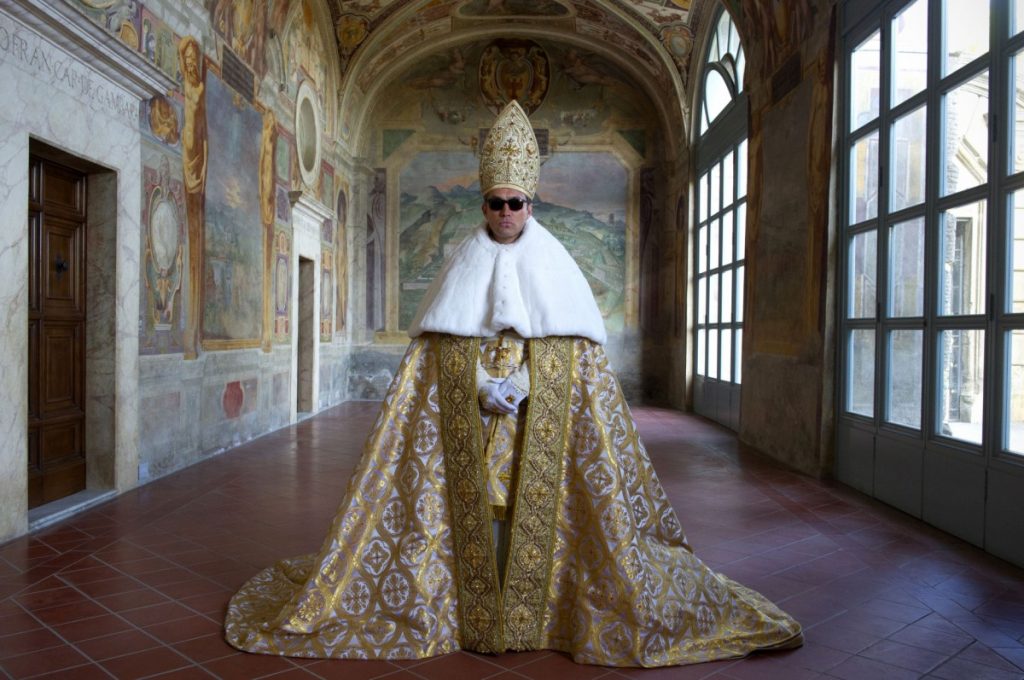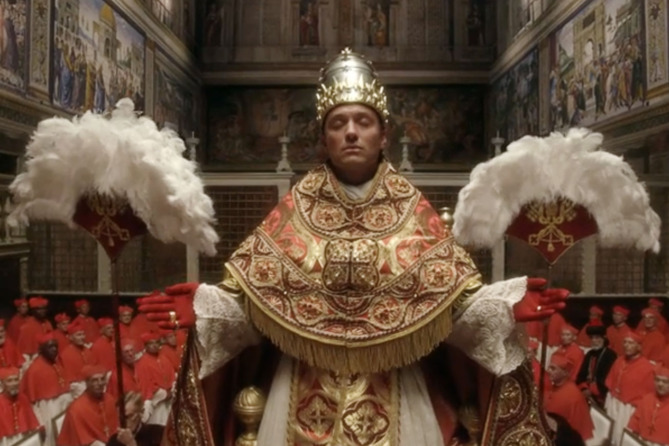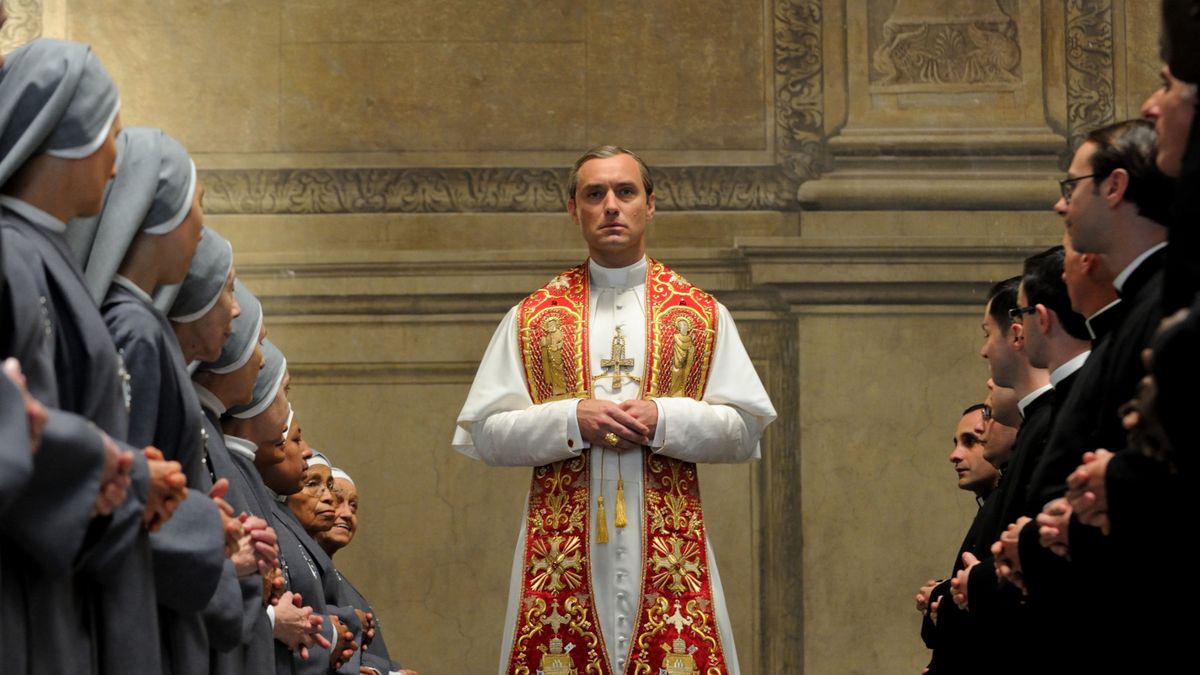The HBO miniseries The Young Pope is a dreamy and often surreal look at the papacy of the fictional Pius XIII: previously Lenny Belardo, the youngest pope in generations is a New Yorker who references Daft Punk and Banksy but is also an arch-conservative who intends to use his papacy to push a reactionary and ostentatiously traditional agenda. (This traditionalism makes for one of the highlights of the series’ many visual treats, the excellent hats and elaborate clothing, much of which harks back to the Middle Ages.) His immediate predecessor is never named, but it seems clear that Lenny is reacting against the determinedly ascetic and media-friendly approach of the current pope. I’d bet good money that no one is Tweeting from @Pontifex in this particular reality.
I began to watch the show thinking that it would be a much more conventional endeavour: The West Wing and its brand of political intrigues transposed to the Vatican. The Young Pope is a much more bizarre and occasionally perplexing piece of television, right from the opening dream sequence when Lenny (played with aplomb by an impressive Jude Law) crawls out into St Peter’s Square from beneath an enormous pile of sleeping infants.
And that’s even before a lone kangaroo takes up residence in the gardens of the Vatican palace.

The show’s ten episodes are by turn surreal, challenging, dazzling and occasionally frustrating. I also think they make excellent fodder for historians who are searching for ways to get students to think about the history of the papacy and Christianity during the European Middle Ages. After all, the medieval papacy can be a difficult institution for students to grapple with—particularly, as is the case of most of my students, when at least a substantial number of them aren’t from a Catholic background and they are raised in a society which at least aspires to the separation of church and state.
I’m not suggesting that much of The Young Pope would make useful viewing in the average college survey course. The idiosyncratic papacy of Pius XIII is very different to that of his historical predecessors. Moreover, for all that Lenny’s meticulously embroidered outfits are obviously chosen to conjure the splendours of papal monarchy, his evocation of the Middle Ages is no more accurate than many of the other attempts to co-opt the medieval past for contemporary political ends. This is a very modern papacy, even if Lenny spends a lot of time dodging photographers and refusing to allow the licensing of commemorative plates (€5 for plastic, €45 for the ceramic ones made by genuine craftsmen).
And this is all before the complex, layered visual symbolism of the show comes into play. I’m actually not sure how much of the show is going to be immediately comprehensible to people who weren’t raised Catholic. (And really, what are we supposed to make of the Vatican’s resident kangaroo amidst all this?)

Yet I think the show is excellent at conveying the world view of a religious fundamentalist whose goals and methods are not those which make immediate sense to a modern, secular mindset. This pope is overtly homophobic, wanting to rid the church of all gay priests even while acknowledging that this might well see the dismissal of fully two-thirds of an already stretched clergy. He opposes reproductive rights and divorce. He has no desire to build bridges. He is overtly and unapologetically authoritarian. “I don’t care about loving my neighbour as myself. I will never love my neighbour as myself,” Lenny proclaims in one episode. For him, his elevation to the papacy is in itself proof of his righteousness and moral superiority.
In other ways, though, his thinking doesn’t fit into the usual modern tropes about religious extremism and how it tends to corrupt and make hypocrites of people. Despite a brief fake-out towards the end of the series, it doesn’t seem that Lenny’s ever been seriously tempted to break his vows of his celibacy. He disdains ecumenicism and wants all Catholics to become “fanatics for God”, but there is little evidence in the show of his endorsing the kinds of “culture wars” which have become so prominent since the middle of the last century. “I put no stock in consensus,” he says; “I have nothing to say to those who have even the slightest doubt about God,” he rails on another occasion. He wants faithful Catholics to turn inwards, not outwards. Lenny would rather a much smaller church made up of True Believers than a more expansive one that makes compromises.
Watching The Young Pope is an exercise in entering into what is for many people—even for many practising Catholics—a very different mindset. Students who are new to the medieval period in particular can struggle with encountering its priests and popes in ways that aren’t anachronistic. They tend to swing between the ideological poles of approving of a Christian Middle Ages as an ideal (if imaginary) time of cultural purity and chivalry that was enabled by the church, or excoriating the church as corrupt and hypocritical the first time they encounter its hierarchy engaged in anything like Realpolitik. A more nuanced and less moralizing reading of the sources is sometimes difficult for students to reach, though it’s one that’s enabled by the show.
For instance, Lenny is frequently hailed as a saint by those around him, with every sign of sincerity. Although this pope openly speaks of using humiliation as a tool to cow others, is casually self-absorbed and frequently cruel (in the very first episode, he makes an elderly nun cry), he may be capable of healing the sick and making the infertile conceive. This clashes with modern ideas of sanctity as comforting and loving. Yet the idea of a saint who punishes people severely for what seem nowadays like minor transgressions wouldn’t have been an odd one in the Middle Ages. (For instance, at least two women were reputed to have gone mad and died for daring to walk through a cemetery dedicated to the English saint Cuthbert.)
“God overwhelms,” Lenny says. “God frightens.”
Of course, the scene in which the pope dons his full regalia to the strains of LMFAO’s “Sexy and I Know It” might just make for excellent classroom viewing regardless. Not only do we get to see the various layers which make up a pope’s formal clothing and which are almost unchanged since the Middle Ages—cassock, lace-embellished cotton tunic, cincture, surplice, papal mantle, red shoes, triregnum and all—but we also get to see how clothing can be used to make a statement about power and authority. Just as a tonsure was an unmistakable sign that the medieval monk had set aside the cares and follies of the secular world, so these clothes turn the orphan Lenny Bellardo into the attention-arresting Pius XIII, bishop of Rome, servant of the servants of God, Christ’s representative on Earth.
And if nothing else, just like much the rest of The Young Pope, the scene makes for viewing that’s trippy, voyeuristic, and brilliantly weird: a trip inside the papal mind.

Pingback: April History Carnival! #164! | Frog in a Well